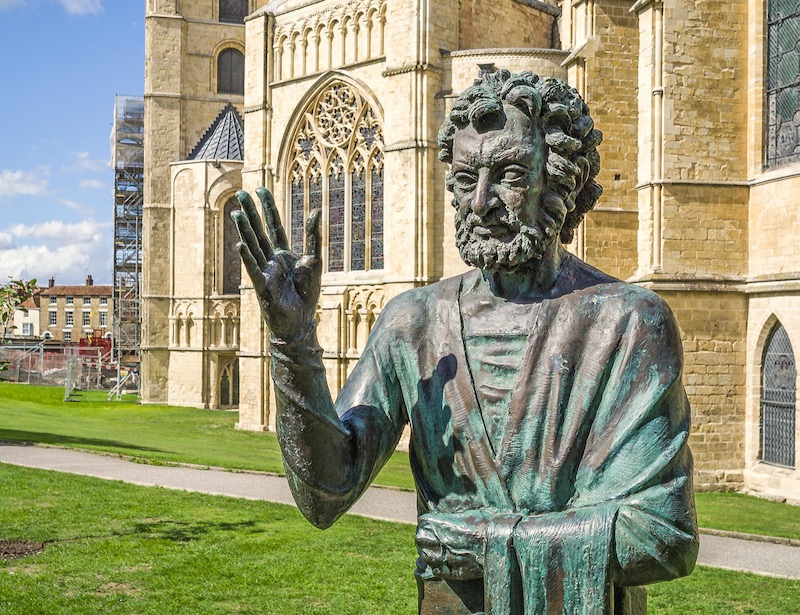At 8am on one Monday morning I found a message in my inbox. It was from a mum whose seven-year-old son had said, as they drove past our church: “If God's head was hanging down like that that means he couldn't breathe.” This, she said, upset him and, although she understood that the crucifix is central to the Catholic faith, she wondered whether we might consider covering the cross (some 12 feet high, hung high upon our wall) or replacing it with a less graphic religious statue.
Indeed she cited the Advertising Standards Authority rules: “Marketing communications must not cause fear or distress without justifiable reason; if it can be justified, the fear or distress should not be excessive”; “Marketers must not use a shocking claim or image merely to attract attention”; and “References to anyone who is dead must be handled with particular care to avoid causing offence or distress.”
I confess my first reaction was to seek the logo of the National Secular Society or Humanists UK at the letter’s foot; my second to ask whether it was a hoax. But the e-mail was written in friendly terms, hoping that I was well at its beginning and sending every good wish at its end. I concluded that it was simply a concerned parent doing what any good parent would do, trying to protect her child, so I replied in gentle terms. I said that her son was quite right; that a body hanging as the figure on our crucifix would indeed have difficulty breathing; indeed this was the Romans’ horrid aim; suffocation when the condemned no longer had the strength to push up against his body-weight to breathe. But I added that Christian faith is that this terrible death was not the end, so that the cross becomes for us a sign of hope.
Secondly, I made the point that it wasn’t really feasible to remove large-scale public works of art, especially significant works such as the Ralph McFall figure carved in situ 57 years ago. More seriously, if we were to do so we would be cutting our culture off from its historical roots, impeding rather than promoting efforts to build a multi-cultural and diverse society. Perhaps, I gently suggested, it would be wiser to use the crucifix as an aid to reflection on the amount of suffering that there is in our world, a reality which would not be reduced one jot by our suburban tendency to airbrush out disturbing images.
Lastly, of course, I invited her to bring her son to visit, saying that I would willingly answer his questions and show them around the church, so that they could see that Catholic faith is a life-affirming, rather than a grizzly religion. A gentle grateful answer came. Maybe when he was older his parents – “atheists but happy for him to find out about all faiths and none” – would bring him to visit. And maybe that particular bright child will be helped by his mum in an age-appropriate way to understand how we can both take suffering seriously and live hope-filled lives.
The little boy saw God. He knew that that is what the man was meant to be. But this God was a suffering God who could not breathe. In fact this God was dead, just a lump of stone, austere, disturbing. “Without beauty, without majesty (we saw him), no looks to attract our eyes” (Isa 53.2) The innocent child had somehow understood without understanding; had understood better, in fact, than those Catholics who do not give the cross a passing thought, so inured are we to it. The child understood but faith was not provoked, only upset; an upset which I dare to hope might at some stage blossom into moral indignation in the face of human suffering. Maybe he will come to call that indignation faith or maybe its opposite.
It’s not about a little boy, though, is it? This Mum’s well-intentioned e-mail captures something of where we are at as a society. While more than a third of the population self-identify still as Christian, half of those are over 50 and church attendance was on the slide long before Covid-19 struck. “Christian” as a label and “Christian” as an indication of sustained religious practice, discipleship, a faith which drives our choices: these are two totally different things. Parish clergy up and down the land are wondering whether the decimation of in-church congregations is a pandemic-shaped blip or a permanent feature; whether online communities can prove both sustainable and sustaining. How many will come back to church in the months ahead and how many have found other things to fill their Sundays and answer their spiritual needs, from yoga and mindfulness to gardening, walking the lockdown puppy and other ways of reconnecting with nature?
By and large we do not know how to interpret religious symbols in this land. Our culture does not teach us anymore that iconic images are for looking through, not looking at, windows on transcendence; that they interrogate us even as we try to interpret them. Here in leafy Surrey a Mum passing in a car turned for a hermeneutic not to Tradition but to the ASA.
It’s easy to lament others’ failure to understand the richness of our Christian heritage. Would it not be more healthy and helpful, though, to ask ourselves whether the God we hang upon our walls can breathe? Do our buildings and, even more importantly, our congregations speak of spirited young life or emphysemic old age? Are we inspired and inspiring, God-breathed individuals joined in God-breathed communities? And are we any better at facing human suffering than our neighbours? Our bowed and burdened sacred head sore wounded is justified in the secular landscape only if those who pass beneath it on their way to mass are Cyrenians who carry others’ crosses, Veronicas who wipe others’ sweat-soaked brows. Let us also be a little more offended by the Cross.
(Fr Rob Esdaile is parish priest of Our Lady of Lourdes, Thames Ditton, Surrey)



 Loading ...
Loading ...
What do you think?
You can post as a subscriber user ...
User comments (0)